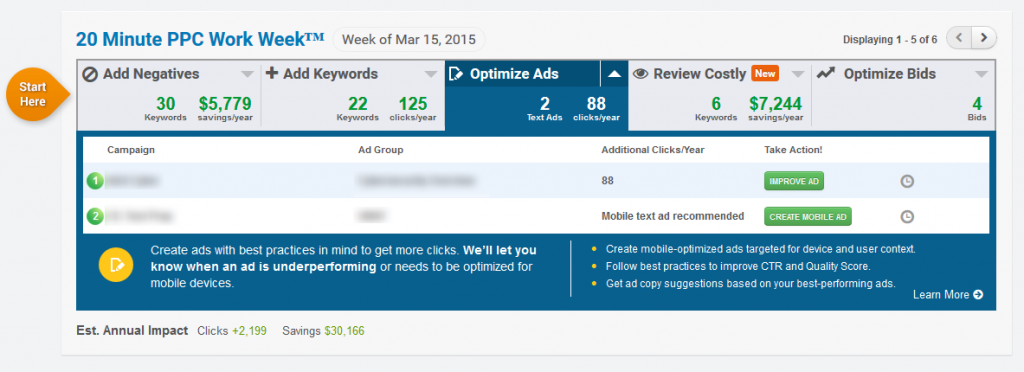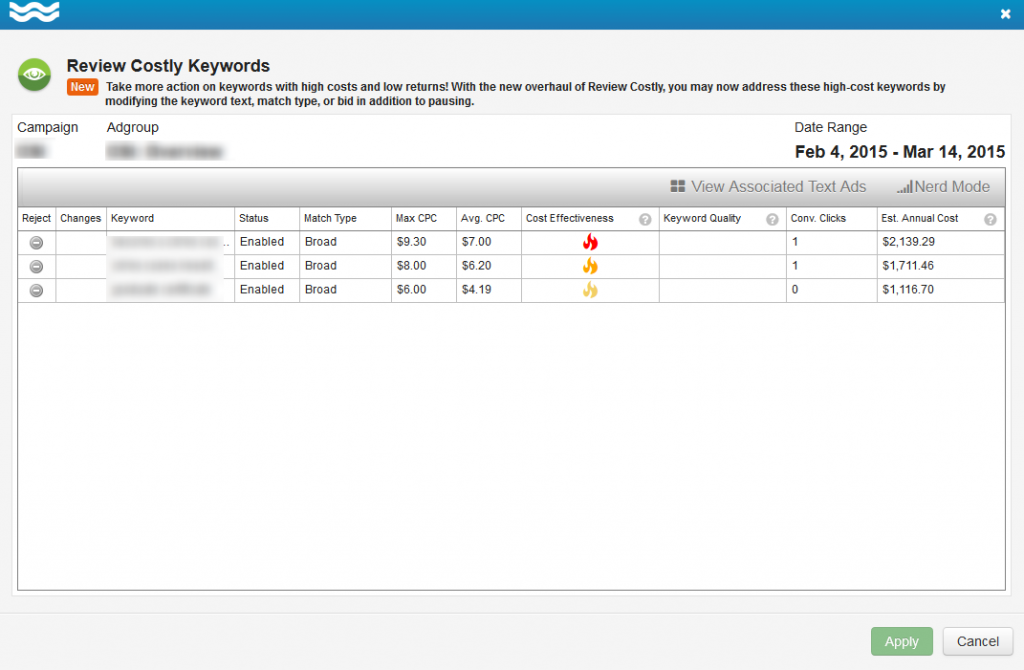As part of our focus on marketing technology, we’re creating a new article series called the Marketing Tech Company Spotlight. Each article in this series will feature an in-depth look at one company that occupies the marketing technology space. The focus of these articles will be to introduce the company (if you haven’t already heard of them), highlight what their specialty is, focus on how they can help you and your company, and even offer a brief overview of their product or service. We’re kicking this series off with a look at WordStream.
If you’re running online PPC campaigns using Google AdWords or Bing Ads and you’re not using WordStream, you’re likely missing out on opportunities. Founded by Larry Kim in 2007, WordStream is a suite of online marketing tools that help with keyword management, and the management of PPC and SEO campaigns. That includes everything from keyword suggestions and analysis to ad optimization and bidding strategy recommendations.
To really understand the product, it’s probably best to start with the company philosophy.
The WordStream Philosophy*
1. Treat Your Keywords as a Valuable, Proprietary Asset
When you create a new PPC campaign, how do you select which keywords to target? Are you guessing? Using the Google Keyword Planner?
It’s important to understand the actual search queries that are used to find your product or service and this is an area where WordStream excels. Organized keyword data is a crucial piece of competitive intelligence and it’s time to start treating it as such.
2. Practice Personalized, Data-Driven Keyword Research
 Are the keywords you’re using truly relevant to your business? WordStream mines YOUR web analytics to find relevant and accurate keywords that real people use to find your site. These are real keyword searches that every day potential customers are using.
Are the keywords you’re using truly relevant to your business? WordStream mines YOUR web analytics to find relevant and accurate keywords that real people use to find your site. These are real keyword searches that every day potential customers are using.
3. Group and Organize Keywords
For PPC, keyword grouping means constructing well-organized, targeted campaigns and ad groups with specific, relevant landing pages. For SEO, this means targeting keywords with quality page content. WordStream helps you group keywords by relevance so they can translated into high-performing ads and optimized web content.
4. Make SEO and PPC Continuous Activities
Are you creating your advertising campaigns using the “set it and forget it” model? Is the only time you check your ads when your traffic drops? If so, you’re missing out on opportunities.
Below is a screenshot from Google Trends showing the history of the search term “BPA free.” For many, that term may not have any meaning, but for those with small children (particularly those born in the 2007 – 2010 time range), BPA free was an important term. In 2008 a report was released linking BPA (a common chemical in plastic) to cancer. Suddenly, the urgency for BPA free plastic containers and bottles spiked.
Companies that sold BPA free products that were using the term BPA free in their product headlines and descriptions saw a spike in sales. However, many companies offered these types of products but did not distinguish the feature or bid on keywords using the term. In other words, they set up their PPC campaigns and forgot about them, missing out on a massive opportunity to capitalize on a brand new and sudden market. WordStream helps make PPC a continuous process so you don’t miss these opportunities.
“The Only Thing That is Constant is Change”
– Heraclitus
5. Connect Research and Analytics with Action
Activity should be driven by a combination of research and analysis on real data and not based on random experiments. Expanding the number of keywords in a campaign might be a great idea, but is it the action that will have the biggest impact on the success of a particular campaign? WordStream helps drive action by translating the data from your campaigns into information you can take immediate action on.
6. Discover and Manage Negative Keywords
Negative keywords are an important part of PPC campaigns. However, before you can understand where negative keywords will help, you need to understand match types first.
| Match Type | Definition | Keyword | Example Search Matches | Won’t Show For… |
|---|---|---|---|---|
| Broad Match | include misspellings, synonyms, related searches, and other relevant variations | women’s hats | buy ladies hates, hats for girls, buy red hats for women | |
| Broad Match Modifier | contain the modified term (or close variations, but not synonyms), in any order | +women’s +hats | hats for women, women’s hats, buy women’s hats | helmets for women |
| Phrase Match | a phrase and close variations of that phrase | “women’s hats” | buy women’s hats, women’s hats, Women’s hats | girls hats, womens baseball hats |
| Exact Match | an exact term and close variations of that exact term | [women’s hats] | women’s hats, woman’s hats | buy women’s hats, women’s hats on sale |
Negative keywords let you specify keywords you don’t want in your search campaigns. For example, if the broad match kitty is one of your keywords but you don’t sell Hello Kitty products or services, you may want to consider hello as a negative keyword so your ad doesn’t show during searches for the term hello kitty.
WordStream recommends negative keywords based on actual searches that match your ad where you may be losing money.
7. Make Strategic Use of Automation
 Not every task is a fit for automation, but some are. WordStream performs continuous keyword research, negative keyword discovery, keyword grouping and organization recommendations, and analytics
Not every task is a fit for automation, but some are. WordStream performs continuous keyword research, negative keyword discovery, keyword grouping and organization recommendations, and analytics
8. Let PPC Inform SEO and Vice Versa
SEO and PPC should compliment one another. The same keywords you’re targeting for a PPC campaign you should also be targeting in your content marketing efforts. When the first organic result in a search matches one of the ads on Google’s results page, the click-through rates are staggering (26% and up).
WordStream brings search marketing tools into one platform. Optimize your PPC campaigns using WordStream and use the keyword research to influence your content marketing and SEO targets.
9. Enable Collaborative Search Marketing Efforts
WordStream provides a single shared workspace used by the entire team. All actions and changes are completely trackable, which provides a streamlined workflow and a more efficient method of managing efforts.
10. Prioritize Search Marketing Tasks to Maximize Time Investment
Let’s face it, PPC can be a full time job. If you have enough campaigns running, it can be difficult to manage and coordinate efforts. WordStream helps teams organize their duties by the importance of each task, helping to prioritize responsibilities and optimize the overall time investment.
Now that you know WordStream’s philosophy, let’s dive into the product starting with the 20 Minute PPC Work Week.
* Read more about the WordStream Philosophy
WordStream and the 20 Minute PPC Work Week
Below is a screenshot of the WordStream dashboard. This is the page you’ll be greeted with when you first login to WordStream.
It’s important to remember that WordStream is a standalone workspace. That means that you need to “GET” your account information and pull it into the workspace. Once you’re done analyzing and making changes, you “PUSH” your changes back into their respective accounts. You can do this using the arrows in the upper right-hand corner of the screen. Once you’ve imported your latest account data, it’s time to get started with the 20 Minute PPC Work Week.
The 20 Minute PPC Work Week is designed to streamline your PPC analysis. It’s broken down into the following 6 sections:
1. Add Negative Keywords
Negative keyword recommendations are broken out by campaign and ad group. These recommendations require actual review as not all of them will be good. However, WordStream uses intelligent processing, so the more recommendations you accept or reject (now bench), the better the future recommendations will become. Adding negative keywords target saving money based on keyword matches that are not a fit.
2. Add Positive Keywords
Positive keyword recommendations work exactly the same as negative keyword recommendations, except they target increased conversions through a valid keyword strategy. These ads, likewise, are broken out by campaign and ad group and will also require actual review.
3. Optimize Ads
Optimize Ads presents opportunities for improving existing ads or creating a new, more focused ad. This may include things like creating a mobile ad, changing the grammar or punctuation of an ad, or other recommendations.
4. Review Costly Ads
Ads can have a high cost for many reasons. The goal of reviewing your costly ads is to determine if they’re effective for your particular campaign. Are you using a poor keyword? Does the ad have a poor quality score? Or perhaps it’s just not converting well. Reviewing costly ads gives you an opportunity to spot and fix problems before they become expensive problems.
5. Optimize Bids
The optimize bids section is focused on recommendations for changes to the bidding strategy on particular keywords. Recommendations include things such as changing the match type (broad, modified broad, phrase, exact) or increasing or decreasing the bidding. Each recommendation also provides a reason for the recommendation, so you can determine if the changes are valuable.
6. Pause Duplicates
When you’re running a lot of campaigns, it’s easy to lose track of all your ads and keywords. WordStream can find situations where you’re actually bidding against yourself!
It’s worth spending at least 20 minutes every week reviewing these recommendations. Even if you do not have the time to dive into all the other features that WordStream offers, spending 20 minutes going through these options will lead to significant improvements over a several month period.
If you do, however, have the time to analyze further, you absolutely must check-out QueryStream.
QueryStream
QueryStream pulls in search queries that triggered your ads over a period of time and shows your data related to each of those queries. You can analyze the performance of campaigns or even individual ads based on actual queries that people are using.
This analysis gives you the opportunity to find new keywords to bid on and new negative keywords to add to your account. You can customize the columns used in your analysis and even search for a particular keyword to focus on.
Conclusion
WordStream is capable of far more than we’re able to include in this brief overview. Hopefully this overview convinces you to take a deeper look because they’re changing the way organizations run campaigns. Their customer service is top notch and the program continues to evolve with new features added regularly. If that wasn’t enough, WordStream can actually help you save more than the cost of using the service! If that’s not enough to convince you, what is?
Learn more at www.wordstream.com.

















